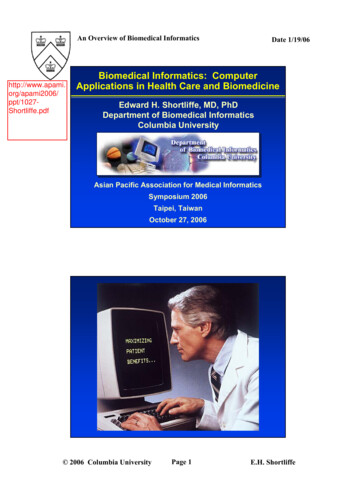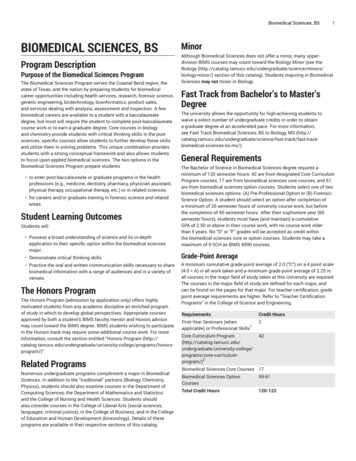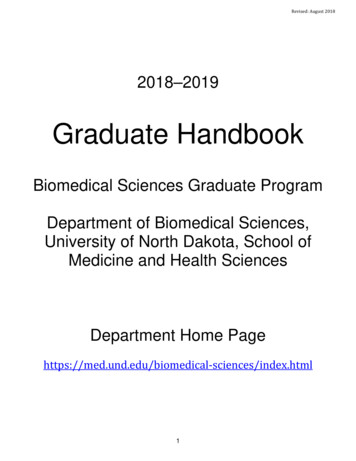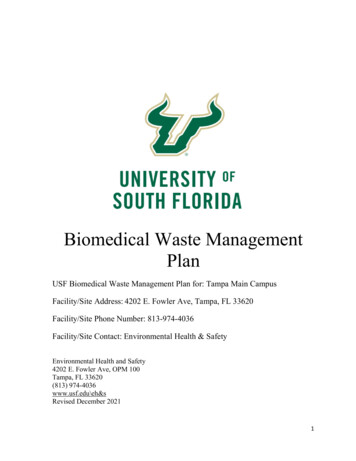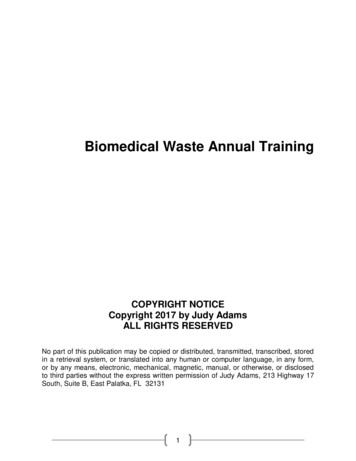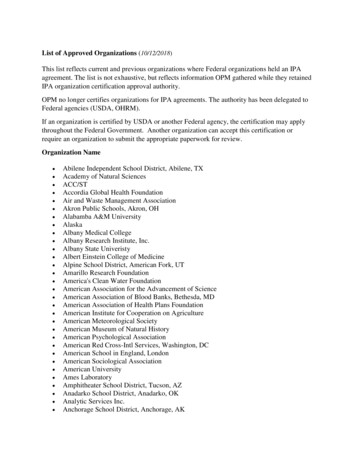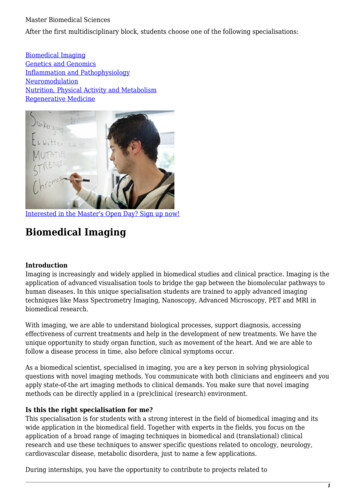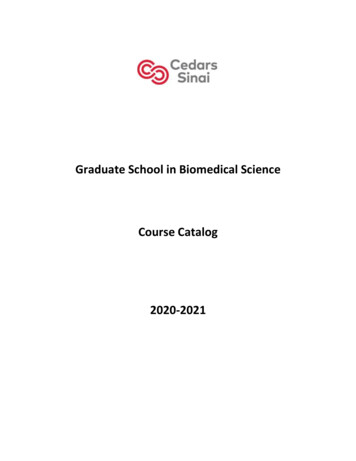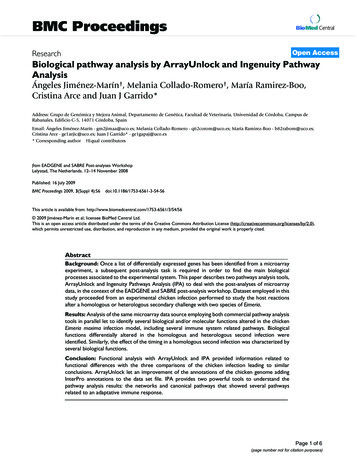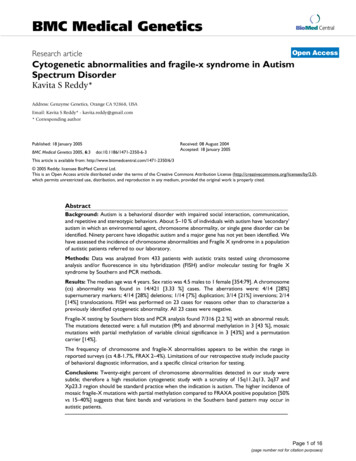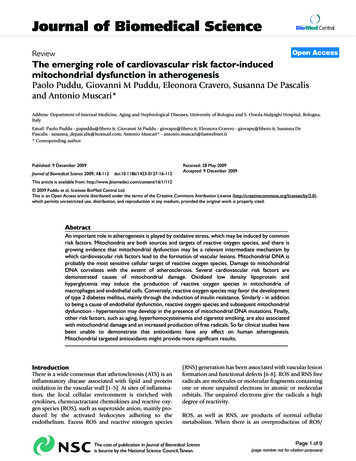
Transcription
Journal of Biomedical ScienceBioMed CentralOpen AccessReviewThe emerging role of cardiovascular risk factor-inducedmitochondrial dysfunction in atherogenesisPaolo Puddu, Giovanni M Puddu, Eleonora Cravero, Susanna De Pascalisand Antonio Muscari*Address: Department of Internal Medicine, Aging and Nephrological Diseases, University of Bologna and S. Orsola-Malpighi Hospital, Bologna,ItalyEmail: Paolo Puddu - papuddu@libero.it; Giovanni M Puddu - giovapu@libero.it; Eleonora Cravero - giovapu@libero.it; Susanna DePascalis - susanna depascalis@hotmail.com; Antonio Muscari* - antonio.muscari@fastwebnet.it* Corresponding authorPublished: 9 December 2009Journal of Biomedical Science 2009, 16:112doi:10.1186/1423-0127-16-112Received: 28 May 2009Accepted: 9 December 2009This article is available from: http://www.jbiomedsci.com/content/16/1/112 2009 Puddu et al; licensee BioMed Central Ltd.This is an Open Access article distributed under the terms of the Creative Commons Attribution License (http://creativecommons.org/licenses/by/2.0),which permits unrestricted use, distribution, and reproduction in any medium, provided the original work is properly cited.AbstractAn important role in atherogenesis is played by oxidative stress, which may be induced by commonrisk factors. Mitochondria are both sources and targets of reactive oxygen species, and there isgrowing evidence that mitochondrial dysfunction may be a relevant intermediate mechanism bywhich cardiovascular risk factors lead to the formation of vascular lesions. Mitochondrial DNA isprobably the most sensitive cellular target of reactive oxygen species. Damage to mitochondrialDNA correlates with the extent of atherosclerosis. Several cardiovascular risk factors aredemonstrated causes of mitochondrial damage. Oxidized low density lipoprotein andhyperglycemia may induce the production of reactive oxygen species in mitochondria ofmacrophages and endothelial cells. Conversely, reactive oxygen species may favor the developmentof type 2 diabetes mellitus, mainly through the induction of insulin resistance. Similarly - in additionto being a cause of endothelial dysfunction, reactive oxygen species and subsequent mitochondrialdysfunction - hypertension may develop in the presence of mitochondrial DNA mutations. Finally,other risk factors, such as aging, hyperhomocysteinemia and cigarette smoking, are also associatedwith mitochondrial damage and an increased production of free radicals. So far clinical studies havebeen unable to demonstrate that antioxidants have any effect on human atherogenesis.Mitochondrial targeted antioxidants might provide more significant results.IntroductionThere is a wide consensus that atherosclerosis (ATS) is aninflammatory disease associated with lipid and proteinoxidation in the vascular wall [1-5]. At sites of inflammation, the local cellular environment is enriched withcytokines, chemoactractant chemokines and reactive oxygen species (ROS), such as superoxide anion, mainly produced by the activated leukocytes adhering to theendothelium. Excess ROS and reactive nitrogen species(RNS) generation has been associated with vascular lesionformation and functional defects [6-8]. ROS and RNS freeradicals are molecules or molecular fragments containingone or more unpaired electrons in atomic or molecularorbitals. The unpaired electrons give the radicals a highdegree of reactivity.ROS, as well as RNS, are products of normal cellularmetabolism. When there is an overproduction of ROS/The cost of publication in Journal of Biomedical Scienceis bourne by the National Science Council, Taiwan.Page 1 of 9(page number not for citation purposes)
Journal of Biomedical Science 2009, 16:112RNS or a deficiency of enzymatic or non-enzymatic antioxidants, a biological damage to cellular lipids (lipoperoxidation), proteins, glucides and DNA may occur.Moreover, nitric oxide (NO) levels are reduced, due toboth decreased production and increased consumption,with possible endothelial dysfunction and vascularimpairment [9]. These harmful effects are termed oxidative and nitrosative stress [10].The toxic effects of free radicals on biomolecules lead tothe accumulation of damage in various cellular locationsand to the deregulation of redox-sensitive metabolic andsignaling pathways, and are also believed to be involvedin pathological conditions such as ATS, hypertension,inflammation, diabetes, cancer and other human pathologies. There is evidence that common risk factors for coronary artery disease are associated with increased levels ofROS [11-16].Recent studies have focused on the role that mitochondriacould play in atherogenesis. In fact, mitochondria areboth important sources and targets of ROS [14,15]. Themitochondrial dysfunction theory postulates that excessrelease of ROS and RNS from mitochondria can contribute to the inflammatory vascular reaction leading to thedevelopment of atherosclerotic lesions [17,18]. In fact,increased mitochondrial ROS production causes endothelial dysfunction, vascular smooth muscle cell (VSMC)proliferation and apoptosis of VSMCs and macrophages,with ensuing ATS lesion progression and possible plaquerupture [18].Common cardiovascular risk factors could be involved inthis process by adversely affecting the function ofendothelial mitochondria, and growing evidence supports the hypothesis that mitochondrial dysfunction maybe the most important unifying mechanism explainingthe atherogenic action of major cardiovascular risk factors[17-19]. This review will discuss the molecular mechanisms by which atherosclerotic risk factors could lead tomitochondrial dysfunction and subsequent vascularimpairment.ROS and RNS production in mitochondriaROS include free radicals (mainly superoxide anion andhydroxyl) and normal molecules (such as hydrogen peroxide [H2O2] and ozone), some of which can be interconverted enzymatically [20]. For example, superoxide isconverted to H2O2 by a family of metallo enzymes such asmanganese superoxide dismutase (Mn SOD) or copper/zinc superoxide dismutase (Cu/Zn SOD) [21,22]. In turn,in the presence of reduced transition metals, H2O2 ismostly transformed in water by glutathione peroxidase orperoxidredoxin III (PRX III) eroxide anion is considered the 'primary' ROS. It maybe formed in the cytosol by reduction of molecular oxygen by the NADPH oxidase and xanthine oxidase. Othercytosolic or membrane-bound sources of ROS are theuncoupled endothelial nitric oxide (NO) synthase(eNOS) and the arachidonate metabolizing enzymeslipoxygenases and cycloxygenases. However, the mitochondrial respiratory chain is the major source of ROS inmost mammalian cells [24-26].Superoxide anion production can occur at complex I andIII in mitochondria [27,28]. Several factors can regulatemitochondrial ROS generation. Zhang and Gutterman[24] have recently reviewed the main molecular pathwaysof ROS production, focusing on the effects of mitochondrial membrane potential, intracellular Ca2 , electrophilic lipids, and NO.Nitrosative stress occurs when the generation of RNS in abiological system exceeds its ability to neutralize them[29,30]. Nitric oxide (NO) is a reactive radical acting as animportant signaling molecule in several physiologicalprocesses. NO and superoxide can react together to produce peroxynitrite anion, which is a potent oxidizingagent capable of causing oxidative damage to biomolecules with subsequent inhibition of their biological function [10].Mitochondrial ROS and RNS, as well as their metabolicproducts such as oxidized lipids, can also play a role insignal transduction through specific modifications of cellsignaling proteins [31-33]. ROS generation in mitochondria is influenced by multiple factors, including the efficiency of the electron transport chain, oxygenconcentration, the availability of electron donors such asNADH and FADH2, the activity of UCPs and cytokines,the activity of antioxidant defenses and the modulation ofnuclear factors [17,34,35]. In this respect, a novel area ofmedical research is now developing.The role of uncoupling proteins (UCPs) in regulating ROSproductionThe mitochondrial respiratory chain requires the expression of gene products encoded by both the nuclear andmitochondrial genome [36]. Human mitochondrialgenome consists of 37 genes coding for 13 proteins thatfunction as subunits for the respiratory complexes I, III,IV, and V, whereas the genes coding for complex II areentirely nuclear. Nuclear genes play a major role in thebiosynthesis of the respiratory chain and the expression ofmitochondrial DNA, and all regulatory factors directingthe expression of both nuclear and mitochondrial respiratory genes are of nuclear origin [36].Page 2 of 9(page number not for citation purposes)
Journal of Biomedical Science 2009, 16:112UCPs are mitochondrial anion transporters present in theinner mitochondrial membrane, and their role in the control of energy conversion in mitochondria has recentlybeen demonstrated. The activation of these anion transporters allows protons to leak back into the mitochondrial matrix, thus decreasing mitochondrial membranepotential and ROS generation [37,38]. UCP2 overexpression inhibits ROS production and apoptosis induced bylinoleic acid and lysophosphatidylcholine [39]. Superoxide activates UCPs, with subsequent down-regulation ofits own production [40,41].The transcriptional regulation of UCP genes, particularlyUCP3 genes, is mediated to a large extent by peroxisomeproliferator activated receptors (PPARs) both in normalconditions and in metabolic diseases such as diabetes orobesity [42]. PPARs, as well as liver receptors, arenuclear receptors significantly involved in the control oflipid metabolism, inflammation, insulin sensitivity and,probably, ATS progression [1,43]. Moreover, PPARs regulate the transcription of mitochondrial and microsomalenzymes [44]. Nunn et al [45] have recently reviewed theinvolvement of PPARs in modulating mitochondrial proton uncoupling and ROS production.Mitochondrial oxidative dysfunctionDamage to mitochondria is caused primarily by the ROSgenerated by mitochondria themselves [34,46], mainlydue to the release of electrons by the coenzymes NADHand FADH into the electron transport chain. In addition,a significant amount of ROS can be produced by mine oxidase located in the outer membrane ofmitochondria [47,48].The deleterious effects resulting from the formation ofROS in mitochondria are prevented to a large extent byvarious antioxidant systems. Under normal conditionsthere is a balance between ROS formation and antioxidants. However, when the antioxidant defenses becomeinsufficient and cannot convert ROS to H2O2 fast enough,oxidative damage occurs and accumulates in the mitochondria [49]. Interestingly, free fatty acids (FFA) candecrease the mitochondrial generation of ROS under conditions of reverse electron transport, due to their uncoupling action. However, under conditions of forwardelectron transport, FFA increase ROS production [50].Although somewhat controversial [51], an NO production does seem to occur in mitochondria through different pathways [52-55]. The NO produced in mitochondria[52,53] counteracts superoxide at multiple levels. It canrapidly scavenge superoxide via direct radical-radical reaction to form peroxynitrite, a potent oxidant [56-60] capable of decreasing the activity of complex I by forming othiols [61]. This in turn reduces mitochondrialROS generation. Moreover, NO can facilitate superoxidescavenging indirectly by stabilizing cytochrome C andpreventing its leakage from mitochondria [24].Asymmetrical dimethyl L-arginine (ADMA), an endogenous NO synthase inhibitor [62], may lead to increasedmitochondrial ROS levels [63]. Mitochondrial ROS production can also be increased by the mitochondrialp66Shc protein, which also favors cytochrome C release,the dissipation of mitochondrial transmembrane potential and apoptosis [64-67].Mitochondrial DNA oxidative damageMitochondrial DNA (mtDNA) is probably the most sensitive cellular target of ROS since it is located close to theinner mitochondrial membrane, where ROS are produced. Moreover, mtDNA is small in size and is not protected by histone proteins as is the case for nuclear DNA[68,69]. Many different types of oxidative DNA lesionshave been described, ranging from base or sugar adductmodifications to single and double-strand breaks [70].The hydroxyl radical can remove protons from deoxyribose, thus producing a sugar radical and inducing strandbreaks and release of the affected DNA base [71]. Moreover, the hydroxyl radical can also abstract a proton fromthe methyl group of thymine and add it to the C4, C5 andC8 position of purines, thereby generating hydroxyadduct radicals [72].mtDNA damage correlates with the extent of ATS [16],suggesting that mitochondrial dysfunction may promoteatherogenesis [1,18,19]. Many of the DNA modificationscan contribute to aging, cancer and neurodegenerativediseases [73], as well as to several other pathophysiological conditions [74]. Damage to mtDNA can have a greaterimpact on cellular function than damage to nuclear DNA[75].The accumulation of mtDNA mutations can cause celldysfunction by altering oxidative phosphorylation andCa2 homeostasis, inducing further oxidative stress and adefective turnover of mitochondrial proteins, and affecting the susceptibility to apoptosis [49]. In particular, themtDNA encoded respiratory enzymes increase electronleak and ROS production, with subsequent enhanced oxidative stress and further damage to mitochondria [76]. Avicious cycle may therefore be generated, leading to progressive accumulation of ROS and oxidative damage tomtDNA [19].DyslipidemiaBoth cholesterol and oxidized low density lipoprotein(oxLDL) can cause mitochondrial damage [17]. Cholesterol feeding in rabbits is associated with impaired mito-Page 3 of 9(page number not for citation purposes)
Journal of Biomedical Science 2009, 16:112chondrial function [77]. Similarly, hypercholesterolemiainduced mtDNA damage in heart homogenates [78]. Freecholesterol (FC) loading of macrophages [79] is associated with mitochondrial dysfunction, as suggested bydecrease in mitochondrial transmembrane potential andactivation of the mitochondrial apoptosis pathway, aprocess playing a key role in atherogenesis. In addition tothe involvement of the classic apoptotic Fas pathway, inFC-loaded macrophages there is evidence of mitochondrial cytocrome C release, caspase 9 activation andincreased levels of the proapoptotic protein Bax [80].The role of redox regulation and lipid rafts in macrophages during ox-LDL-mediated foam cell formation hasrecently been reviewed [81]. Circulating ox-LDL represents an independent risk factor for ATS and acute cardiovascular diseases. Ox-LDL causes the mitochondrialproduction of ROS in endothelial cells, a process associated with apoptosis [82,83], through the activation ofmitochondrial complex II [84], uncoupled eNOS, and theNADPH oxidases [85]. The exposure of endothelial progenitor or mature cells to ox-LDL results in an increasedproduction of mitochondria-derived superoxide, withassociated increase in p53 expression and subsequent activation of Bax. The activated Bax translocates into the mitochondria to release cytochrome C, which elicits theapoptotic reaction. Bax is a member of multidomain Bcl2 proapoptotic proteins, and its activation and translocation into the mitochondria has been shown to cause mitochondrial dysfunction and cell apoptosis [86]. Cheng et al[84] have demonstrated that superoxide anion, but nothydrogen peroxide, can activate p53 and Bax. The superoxide regulation of Bax does not consist in an increase inBax expression, but rather in an activation through a conformational change.Vindis et al. [87] have recently shown the involvement oftwo distinct calcium-dependent mechanisms in ox-LDLinduced apoptosis: the first is mediated by calpain/mitochondrial permeability transitionpore/cytochrome C/caspase, while the second is mediated by a mitochondrialapoptosis inducing factor, which is cyclosporin-insensitive and caspase-independent. Ox-LDL induces apoptosisin all cells involved in ATS: endothelial cells, VSMCs, macrophages, and T lymphocytes [88,89].DiabetesType 2 diabetes mellitus (T2DM) is a multifactorial, heterogeneous, polygenic disease that accounts for 90%of all types of diabetes. In T2DM insulin resistance is themajor pathologic feature, which often causes a compensatory increase of insulin secretion [90]. ROS are now considered a major factor in the onset and development ofT2DM. ROS can induce inactivation of the signaling pathway between the insulin receptor and the glucose rter system, leading to insulin resistance [91]. On theother hand, in addition to being a possible effect of ROSproduction, T2DM is also a cause of oxidative stress, withensuing atherogenic effect [92]. Hyperglycemia inducessuperoxide generation in endothelial cells, and most ofthis superoxide may be produced by mitochondria [93].In diabetes, electron transfer and oxidative phosphorylation are uncoupled, resulting in superoxide formation andinefficient ATP synthesis [23]. Prevention of oxidativedamage represents a therapeutic strategy in diabetes [23].In T2DM the elevation of free fatty acid (FFA) concentrations, with subsequent intramyocellular lipid accumulation, has been proposed as a cause of further insulinresistance and also pancreatic beta-cell death [94,95]. Ithas been reported [96,97] that both glucose and FFAs mayinitiate the formation of ROS via mitochondrial andNADPH oxidase mechanisms in muscles, adipocytes, betacells and other cells. FFAs penetrate cellular organellesincluding mitochondria, where high ROS levels will resultin lipid peroxidation and mitochondrial injury [98].Interestingly, recent studies revealed that T2DM and insulin resistance are associated with a decreased mitochondrial oxidation function in skeletal muscle [99].Moreover, in T2DM mitochondria are smaller, round andprone to produce superoxide [100]. Disorders of the mitochondrial transport chain, overgeneration of ROS andlipoperoxides or impairments in antioxidant defenseshave been reported in T2DM, as well as in obesity.HypertensionLike other risk factor for ATS, human hypertension is acondition associated with endothelial dysfunction andoxidative stress [101-107]. Mitochondrial dysfunction hasbeen potentially implicated in both human and experimental hypertension [108,109]. Deterioration of mitochondrial energy production plays a role in thepathogenesis of hypertension in both spontaneouslyhypertensive rats (SHRs) [110,111] and mice [112]. Mitochondrial energy deficiency [113] and a decreased activityof complex IV have been observed in the hypertrophiedmyocardium from SHRs [114]. In these animals there isalso an abnormal transport of inorganic phosphate in leftventricular mitochondria [115]. Overall, these data indicate that some defect in the regulation of mitochondrialATP synthase activity occurs in the cardiomyocites ofSHRs. In addition, mitochondrial calcium overload couldsignificantly contribute to the development of hypertensive states [113].An association of hypertension with mitochondrialuncoupling proteins (UCPs) has been reported both inexperimental and human hypertension. In particular,mice with doxycycline-inducible expression of UCP 1 inPage 4 of 9(page number not for citation purposes)
Journal of Biomedical Science 2009, terial walls develop hypertension and dietary ATS [112].A common polymorphism of the UCP2 gene was associated with hypertension in a Japanese population, andwith hypertension and obesity in Caucasians [116].Thus, a range of seemingly unrelated conditions hasunderlying pathophysiological mechanisms in common,namely ROS production and accumulation of mtDNAdamage, resulting in mitochondrial dysfunction and ATS.ROS and RNS can damage mtDNA [117], with decreasedenergy production, additional generation of ROS, andenhancement of the cellular signals capable of initiatinghypertension, as well as ATS [117]. mtDNA mutationshave been demonstrated in black Americans with hypertension-associated end-stage renal disease [118]. Moreover, it has been shown that a mutation in mitochondrialtRNA is associated with hypertension, hypercholesterolemia and hypomagnesemia [119]. The putative role ofmitochondrial dysfunction in hypertension has beenrecently reviewed [120].ConclusionAging, hyperhomocysteinemia, cigarette smoking and HIVas risk factorsAging significantly increases the risk of coronary heart disease and other vascular diseases. Several human and animal studies have shown an age-related impairment ofmitochondrial respiratory chain function and ATP synthesis, together with an accumulation of oxidative mtDNAmutations [18]. It has been suggested that mitochondrialdysfunction is a major contributor to aging and agingassociated ATS [18].Elevated plasma homocysteine is an independent risk factor for ATS. It has been proposed that endothelial dysfunction and ATS can be induced by homocysteine throughincreased generation of ROS and reduced NO availability[121-124]. Austin e al. [125] have shown that homocysteine promotes mitochondrial damage and alters mitochondrial gene expression and function. Further,homocysteine stimulates the expression of NRF1 and Tfam, two nuclear transcription factors involved in themodulation of mitochondrial biogenesis. This effect wasprevented by pre-treatment with antioxidants, suggestingthat ROS are important mediators of the effects of homocysteine. In addition, homocysteine induces endothelialcell apoptosis through mitochondrial mechanisms[126,127].Cigarette smoking may significantly increase the risk ofearly ATS by affecting mitochondrial function. In fact, inaddition to endothelial injury, platelet activation and LDLoxidation, the atherogenic effects of cigarette smokinginclude oxidative mtDNA damage with mtDNA deletionsand loss of mitochondrial membrane potential [13,128131].Finally, mitochondrial dysfunction can also be considereda contributing factor for HIV-associated ATS [132-134].Based on experimental evidence and clinical studies, oxidative and nitrosative stress have been shown to beinduced by ATS risk factors and to contribute to the onsetand development of atherosclerotic vascular damage.Moreover, endogenous risk factors, such as hypertensionand diabetes, may be both the cause of vascular ROS generation and a consequence of ROS induced endothelialdysfunction.Under physiological conditions, the mitochondrial respiratory chain is a major source of superoxide and otherROS [135-139]. This mechanism may be triggered by riskfactors, with subsequent endothelial dysfunction andatherogenesis. On the other hand, mitochondria may benot only a relevant source, but also a target of ROS[14,15]. In fact, an excessive production of ROS in mitochondria will damage lipids, carbohydrates, and proteins,as well as mtDNA. Indeed, oxidative mtDNA mutationscould represent an important step in the chain of eventsconnecting risk factors to atherogenesis, acting as furthercauses of ROS generation [78,140]. Ballinger et al. [16]suggested that mitochondrial damage in an early stage canpredict ROS and RNS-mediated atherosclerotic lesions.Overall, the pathogenetic role of mitochondrial dysfunction in atherogenesis may now be considered more than aplausible hypothesis [19].Despite the experimental evidence of the importance ofoxidative stress in inducing ATS, clinical studies have beenunable to demonstrate that antioxidants have any effecton human atherogenesis [141-143]. Some studies haveshown that antioxidants such as alpha tocopherol, ubiquinone and N-acetylcysteine could decrease mitochondrial oxidative damage in different experimental models[144-148]. However, the effectiveness of these compounds is limited, since they do not significantly accumulate within mitochondria [149], and strategies for thetargeted delivery of antioxidants to mitochondria are nowin the developmental stages [150]. In fact the antioxidantmoieties can be bound by covalent attachment tolipophilic triphenylphosphonium cations, which, due tothe large mitochondrial membrane potential, do accumulate within the mitochondria [151]. The targeted versionof ubiquinol (MitoQ) has been used most extensively[151,152], and is now being tested in man as an oral drugfor the treatment of hepatitis C [153] and Parkinson's disease [154]. However, despite these promising data, morepre-clinical and clinical studies are needed in order toPage 5 of 9(page number not for citation purposes)
Journal of Biomedical Science 2009, 16:112evaluate both the effectiveness and the safety of mitochondria targeted antioxidants.Competing interestsThe authors declare that they have no competing 1218.19.20.Authors' contributions21.PP designed the article and wrote the first draft. GMP specifically prepared the sections concerning mitochondrialoxidative dysfunction and mitochondrial DNA oxidativedamage. EC specifically prepared the sections concerningdyslipidemia and diabetes. SDP contributed to literaturesearch and edited the manuscript. AM participated indesigning the article, revised critically the manuscript, andre-arranged the final version. All authors read andapproved the final 8.9.10.11.12.13.14.15.16.17.Puddu GM, Cravero E, Arnone G, Muscari A, Puddu P: Molecularaspects of atherogenesis: new insights and unsolved questions. J Biomed Sci 2005, 12:839-853.Stocker R, Keaney JF Jr: Role of oxidative modifications inatherosclerosis. Physiol Rev 2004, 84:1381-1478.Navab M, Ananthramaiah GM, Reddy ST, Van Lenten BJ, Ansell BJ,Fonarow GC, Vahabzadeh K, Hama S, Hough G, Kamranpour N, Berliner JA, Lusis AJ, Fogelman AM: The oxidation hypothesis ofatherogenesis: the role of oxidized phospholipids and HDL. JLipid Res 2004, 45:993-1007.Madamanchi NR, Vendrov A, Runge MS: Oxidative stress and vascular disease. Arterioscler Thromb Vasc Biol 2005, 25:29-38.Bergt C, Pennathur S, Fu X, Byun J, O'Brien K, McDonald TO, SinghP, Anantharamaiah GM, Chait A, Brunzell J, Geary RL, Oram JF, Heinecke JW: The myeloperoxidase product hypochlorous acidoxidizes HDL in the human artery wall and impairs ABCA1dependent cholesterol transport. Proc Natl Acad Sci USA 2004,101:13032-13037.Ross R: The pathogenesis of atherosclerosis: a perspective forthe 1990s. Nature 1993, 362:801-809.Berliner JA, Heinecke JW: The role of oxidized lipoproteins inatherogenesis. Free Radic Biol Med 1996, 20:707-727.Freeman BA, White CR, Gutierrez H, Paler-Martínez A, Tarpey MM,Rubbo H: Oxygen radical-nitric oxide reactions in vasculardiseases. Adv Pharmacol 1995, 34:45-69.Victor VM, Rocha M, Solá E, Bañuls C, Garcia-Malpartida K, Hernández-Mijares A: Oxidative stress, endothelial dysfunction andatherosclerosis. Curr Pharm Des 2009, 15:2988-3002.Valko M, Leibfritz D, Moncol J, Cronin MT, Mazur M, Telser J: Freeradicals and antioxidants in normal physiological functionsand human disease. Int J Biochem Cell Biol 2007, 39:44-84.Alexander RW: Atherosclerosis as disease of redox-sensitivegenes. Trans Am Clin Climatol Assoc 1998, 109:129-145.Ito H, Torii M, Suzuki T: Decreased superoxide dismutase activity and increased superoxide anion production in cardiachypertrophy of spontaneously hypertensive rats. Clin ExpHypertens 1995, 17:803-816.van Jaarsveld H, Kuyl JM, Alberts DW: Exposure of rats to lowconcentration of cigarette smoke increases myocardial sensitivity to ischaemia/reperfusion. Basic Res Cardiol 1992,87:393-399.Esposito LA, Melov S, Panov A, Cottrell BA, Wallace DC: Mitochondrial disease in mouse results in increased oxidative stress.Proc Natl Acad Sci USA 1999, 96:4820-4825.Wallace DC: Mitochondrial genetics: a paradigm for aging anddegenerative diseases? Science 1992, 256:628-632.Ballinger SW, Patterson C, Knight-Lozano CA, Burow DL, ConklinCA, Hu Z, Reuf J, Horaist C, Lebovitz R, Hunter GC, McIntyre K,Runge MS: Mitochondrial integrity and function in atherogenesis. Circulation 2002, 106:544-349.Ballinger SW: Mitochondrial dysfunction in cardiovascular disease. Free Radic Biol Med 2005, 9.40.41.Madamanchi NR, Runge MS: Mitochondrial dysfunction inatherosclerosis. Circ Res 2007, 100:460-473.Puddu P, Puddu GM, Galletti L, Cravero E, Muscari A: Mitochondrial dysfunction as an initiating event in atherogenesis: aplausible hypothesis. Cardiology 2005, 103:137-141.Pourova J, Kottova M, Voprsalova M, Pour M: Reactive oxygen andnitrogen species in normal physiological processes. Acta Physiol (Oxf) 2009 in press.Pieczenik SR, Neustadt J: Mitochondrial dysfunction and molecular pathways of disease. Exp Mol Pathol 2007, 83:84-92.Wallace DC: A mitochondrial paradigm of metabolic anddegenerative diseases, aging, and cancer: a dawn for evolutionary medicine. Annu Rev Genet 2005, 39:359-407.Green K, Brand MD, Murphy MP: Prevention of mitochondrialoxidative damage as a therapeutic strategy in diabetes. Diabetes 2004, 53(Suppl 1):S110-S118.Zhang DX, Gutterman DD: Mitochondrial reactive oxygen species mediated signaling in endothelial cells. Am J Physiol HeartCirc Physiol 2007, 292:2023-2031.Li JM, Shah AM: Endothelial cell superoxide generation: regulation and relevance for cardiovascular pathophysiology. AmJ Physiol Regul Integr Comp Physiol 2004, 287:1014-1030.Mueller CF, Laude K, McNally JS, Harrison DG: ATVB in focus:redox mechanisms in blood vessels. Arterioscler Thromb Vasc Biol2005, 25:274-278.Davidson SM, Duchen MR: Endothelial mitochondria: contributing to vascular function and disease.Circ Res 2007,100:1128-1141.O'Malley Y, Fink BD, Ross NC, Prisinzano TE,
medical research is now developing. The role of uncoupling proteins (UCPs) in regulating ROS production The mitochondrial respiratory chain requires the expres-sion of gene products encoded by both the nuclear and mitochondrial genome [36]. Human mitochondrial genome consists of 37 genes coding for 13 proteins that
